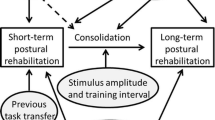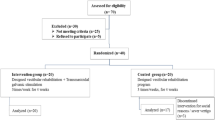Abstract
We aimed to determine the early efficacy of vestibular rehabilitation with electrotactile vestibular substitution system (EVSS) as a new treatment modality in patients with bilateral vestibular loss due to aminoglycoside-induced ototoxicity. Six men and four women with bilateral vestibular failure were rehabilitated with EVSS prospectively. Patients were trained with EVSS for ten sessions each lasted 20 min, two sessions per day. Sensory organization test (SOT) protocol and dizziness handicap inventory (DHI) were used to compare pre- and post-training results of the rehabilitative treatment. Post-training tests were done at the first day of post-treatment period. All ten patients in the standardized testing subset demonstrated improved scores in the composite SOT scores and in the functional transfer testing with DHI after 5 days of training with the EVSS. In conclusion, these preliminary results demonstrate efficacy of the EVSS in improving patients symptoms and signs and signify the evidence of sensory substitution in the early post-training period.


Similar content being viewed by others
References
Gillespie MB, Minor LB (1999) Prognosis in bilateral vestibular hypofunction. Laryngoscope 109(1):35–41. doi:10.1097/00005537-199901000-00008
Rinne T, Bronstein AM, Rudge P, Gresty MA, Luxon LM (1995) Bilateral loss of vestibular function. Acta Otolaryngol Suppl 520(Pt 2):247–250. doi:10.3109/00016489509125239
Lee H, Yi HA, Lee SR, Ahn BH, Park BR (2005) Drop attacks in elderly patients secondary to otologic causes with Meniere’s syndrome or non-Meniere peripheral vestibulopathy. J Neurol Sci 232:71–76. doi:10.1016/j.jns.2005.01.012
Brown KE, Whitney SL, Wrisley DM, Furman JM (2001) Physical therapy outcomes for persons with bilateral vestibular loss. Laryngoscope 111(10):1812–1817. doi:10.1097/00005537-200110000-00027
Telian SA, Shepard NT, Smith-Wheelock M, Hoberg M (1991) Bilateral vestibular paresis: diagnosis and treatment. Otolaryngol Head Neck Surg 104(1):67–71
Whitney SL, Marchetti GF, Schade AI (2006) The relationship between falls history and computerized dynamic posturography in persons with balance and vestibular disorders. Arch Phys Med Rehabil 87(3):402–407. doi:10.1016/j.apmr.2005.11.002
Bach-y-Rita P, Danilov YP, Tyler ME, Grimm RJ (2005) Late human brain plasticity: vestibular substitution with a tongue Brain Port human–machine interface. J Intellectica 40:115–122
Jacobson GP, Newman CW (1990) The development of the Dizziness Handicap Inventory. Arch Otolaryngol Head Neck Surg 116:424–427
Whitney SL, Wrisley DM, Brown KE, Furman JM (2004) Is perception of handicap related to functional performance in persons with vestibular dysfunction? Otol Neurotol 25(2):139–143. doi:10.1097/00129492-200403000-00010
Danilov Y, Tyler M (2005) Brainport: an alternative input to the brain. J Integr Neurosci 4(4):537–550. doi:10.1142/S0219635205000914
Bach-Y-Rita P (2005) Emerging concepts of brain function. J Integr Neurosci 4(2):183–205. doi:10.1142/S0219635205000768
Bach-y-Rita P, W Kercel S (2003) Sensory substitution and the human–machine interface. Trends Cogn Sci 7(12):541–546. doi:10.1016/j.tics.2003.10.013
Cowand JL, Wrisley DM, Walker M, Strasnick B, Jacobson JT (1998) Efficacy of vestibular rehabilitation. Otolaryngol Head Neck Surg 118(1):49–54. doi:10.1016/S0194-5998(98)70374-2
Uneri A, Polat P (2008) Vertigo, dizziness and imbalance in the elderly. J Laryngol Otol 122(5):466–469. doi:10.1017/S0022215107000424
Sampaio E, Maris S, Bach-y-Rita P (2001) Brain plasticity: ‘visual’ acuity of blind persons via the tongue. Brain Res 908(2):204–207. doi:10.1016/S0006-8993(01)02667-1
Wall PD (1980) Mechanisms of plasticity of connection following damage in adult mammalian nervous systems. In: Bach-y-Rita P (ed) Recovery of function: theoretical considerations for brain injury rehabilitation. Hans Huber, Bern, pp 91–105
Ptito M, Moesgaard SM, Gjedde A et al (2005) Crosss-modal plasticity revealed by electrotactile stimulation of the tongue in the congenitally blind. Brain 128:606–614. doi:10.1093/brain/awh380
Tyler M, Danilov Y, Bach-y-Rita P (2003) Closing an open-loop control system: vestibular substitution through the tongue. J Integr Neurosci 2(2):159–164. doi:10.1142/S0219635203000263
Acknowledgments
The authors thanks Omer Utku Erzengin, PhD, Department of Biostatistics, Tubitak MAM, for his support and statistical analysis, and Ayer Kucukmetin AS, for her support in collecting data and the help in the training sessions.
Conflict of interest
There was no financial support for this study.
Author information
Authors and Affiliations
Corresponding author
Rights and permissions
About this article
Cite this article
Uneri, A., Polat, Ş. Vestibular rehabilitation with electrotactile vestibular substitution: early effects. Eur Arch Otorhinolaryngol 266, 1199–1203 (2009). https://doi.org/10.1007/s00405-008-0886-3
Received:
Accepted:
Published:
Issue Date:
DOI: https://doi.org/10.1007/s00405-008-0886-3




